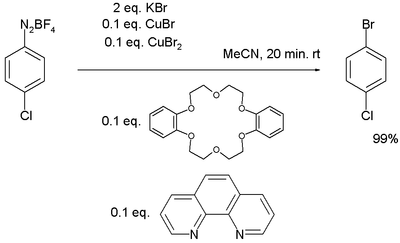Sandmeyer-reakció
A Sandmeyer-reakció diazóniumsókból aril-halogenid előállítására használható szerves reakció.[1][2][3] Nevét Traugott Sandmeyer svájci kémikus után kapta. A reakció aromás aminocsoport diazóniumsón keresztül nukleofillel történő helyettesítése, mely többnyire réz(I)-sóval katalizálható. A nukleofil többek között lehet halogenidion, cianid, tiol, víz stb. is. Fluoridionnal a reakció nem megy végbe, de a fluorozás is megvalósítható a hasonló Schiemann-reakció segítségével.
Reakciómechanizmus
[szerkesztés]Az aromás (vagy heterociklusos) aminok nitritekkel gyors reakcióban aril diazóniumsót képeznek, melyek réz(I)-sók, például réz(I)-klorid jelenlétében elbomlanak, a kívánt aril-halogenidet szolgáltatva.[4][5] A reakciót 25–30 °C hőmérsékleten végzik. A reakció aromás gyökös-nukleofil szubsztitúció.[forrás?]
A reakció kezdeti formájához képest számos fejlesztést tettek.[6][7]
Változatok
[szerkesztés]A legtöbb változat az alkalmazott rézsóban különbözik.[8][9] Réz(I)-cianiddal például benzonitril állítható elő.[10] Rézsó helyett tiolt vagy vizet használva tioéter, illetve fenol keletkezik. A Schiemann-reakció tetrafluoroborát felhasználásával fluorbenzolt szolgáltat, amely réz-fluorid hatására nem keletkezne.
Katalitikus mennyiségű rézsót alkalmazó Sandmeyer-reakciók is ismeretesek. Az egyik brómozási eljárás 0,2 ekvivalens Cu(I)/Cu(II) keverék, valamint fenantrolin kétfogú ligandum és dibenzo-18-korona-6 fázistranszfer katalizátor mellett történik:[11]
A Sandmeyer-reakció egyik változatában amil-nitrit reagenst használnak. Az alkil-nitritek aromás aminokkal halogénezett oldószerben aromás gyököket eredményeznek, amelyek az oldószermolekulából halogénatomot képesek elvonni. Aril-jodidok szintéziséhez dijódmetánt használnak,[12][13] míg aril-bromidok előállításához a bromoform a megfelelő oldószer.[14]
Jegyzetek
[szerkesztés]- ↑ Traugott Sandmeyer (1884). „Ueber die Ersetzung der Amidgruppe durch Chlor in den aromatischen Substanzen”. Berichte der deutschen chemischen Gesellschaft 17 (3), 1633–1635. o. DOI:10.1002/cber.18840170219.
- ↑ Traugott Sandmeyer (1884). „Ueber die Ersetzung der Amid-gruppe durch Chlor, Brom und Cyan in den aromatischen Substanzen”. Berichte der deutschen chemischen Gesellschaft 17 (4), 2650–2653. o. DOI:10.1002/cber.188401702202.
- ↑ Ludwig Gattermann (1890). „Untersuchungen über Diazoverbindungen”. Berichte der deutschen chemischen Gesellschaft 23 (1), 1218–1228. o. DOI:10.1002/cber.189002301199.
- ↑ J. K. Kochi (1957). „The Mechanism of the Sandmeyer and Meerwein Reactions”. J. Am. Chem. Soc. 79 (11), 2942–2948. o. DOI:10.1021/ja01568a066.
- ↑ H. H. Hodgson (1947). „The Sandmeyer Reaction”. Chem. Rev. 40 (2), 251–277. o. DOI:10.1021/cr60126a003.
- ↑ M. P. Doyle, B. Siegfried and J. F. Dellaria (1977). „Alkyl nitrite-metal halide deamination reactions. 2. Substitutive deamination of arylamines by alkyl nitrites and copper(II) halides. A direct and remarkably efficient conversion of arylamines to aryl halides”. J. Org. Chem. 42 (14), 2426–2431. o. DOI:10.1021/jo00434a017.
- ↑ Suzuki, N. et al. Perkins Trans. I 1987, 645.
- ↑ Jonathan L. Hartwell (1955). „o-Chlorobromobenzene”. Org. Synth.. ; Coll. Vol. 3: 185
- ↑ F. D. Gunstone and S. Horwood Tucker (1963). „1-Chloro-2,6-dinitrobenzene”. Org. Synth.. ; Coll. Vol. 4: 160
- ↑ H. T. Clarke and R. R. Read (1941). „o-Tolunitrile and p-Tolunitrile”. Org. Synth.. ; Coll. Vol. 1: 514
- ↑ P. Beletskaya, Alexander S. Sigeev, Alexander S. Peregudov, Pavel V. Petrovskii (2007). „Catalytic Sandmeyer Bromination”. Synthesis 2007 (16), 2534–2538. o. DOI:10.1055/s-2007-983784.
- ↑ (1990) „Application of the isoamyl nitrite-diiodomethane route to aryl iodides”. J. Org. Chem. 55 (8), 2543–2545. o. DOI:10.1021/jo00295a056.
- ↑ (1982) „(({title))}”. Synthesis, 670–672. o.
- ↑ (1966) „An alternative to the Sandmeyer reaction”. J. Chem. Soc., 1249–1250. o. DOI:10.1039/J39660001249.
Fordítás
[szerkesztés]Ez a szócikk részben vagy egészben a Sandmeyer reaction című angol Wikipédia-szócikk ezen változatának fordításán alapul. Az eredeti cikk szerkesztőit annak laptörténete sorolja fel. Ez a jelzés csupán a megfogalmazás eredetét és a szerzői jogokat jelzi, nem szolgál a cikkben szereplő információk forrásmegjelöléseként.
További információk
[szerkesztés]Text is available under the CC BY-SA 4.0 license; additional terms may apply.
Images, videos and audio are available under their respective licenses.


